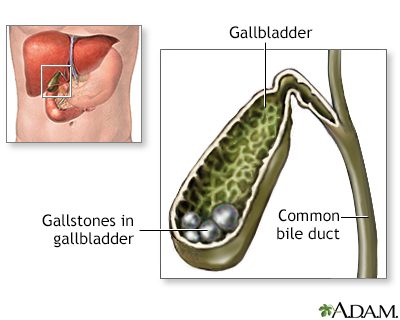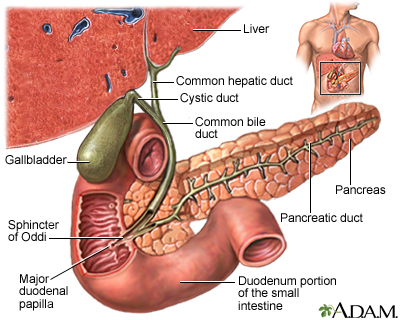Gallstones
Cholelithiasis; Gallbladder attack; Biliary colic; Gallstone attack; Biliary calculus: gallstones chenodeoxycholic acids (CDCA); Ursodeoxycholic acid (UDCA, ursodiol); Endoscopic retrograde cholangiopancreatography (ERCP) - gallstones
Gallstones are hard deposits that form inside the gallbladder. These may be as small as a grain of sand or as large as a golf ball.
Images






Presentation

I Would Like to Learn About:
Causes
The cause of gallstones varies. There are two main types of gallstones:
- Stones made of cholesterol -- This is the most common type. Cholesterol gallstones are not related to cholesterol level in the blood. In most cases, they are not visible on CT scans but are visible on a sonogram (ultrasound) of the abdomen.
- Stones made of bilirubin -- These are called pigment stones. They occur when red blood cells are destroyed and too much bilirubin is in the bile.
Gallstones are more common in:
- Female sex
- Native Americans and people of Hispanic descent
- People over age 40
- People who are overweight
- People with family history of gallstones
The following factors also make you more likely to develop gallstones:
- Bone marrow or solid organ transplant
- Diabetes
- Failure of the gallbladder to empty bile properly (this is more likely to happen during pregnancy)
- Liver cirrhosis and biliary tract infections (pigmented stones)
- Medical conditions that cause too many red blood cells to be destroyed
- Rapid weight loss from eating a very low-calorie diet, or after weight loss surgery
- Receiving nutrition through a vein for a long period of time (intravenous feedings)
- Taking birth control pills
Symptoms
Many people with gallstones do not have any symptoms. These are often found during a routine x-ray, abdominal surgery, or other medical procedure.
However, if a large stone blocks a tube or duct that drains the gallbladder, you may have a cramping pain in the middle to right upper abdomen. This is known as biliary colic. The pain goes away if the stone passes into the first part of the small intestine.
Symptoms that may occur include:
- Pain in the right upper or middle upper abdomen for at least 30 minutes. The pain may be constant or cramping. It can feel sharp or dull.
- Fever.
- Yellowing of skin and whites of the eyes (jaundice).
Other symptoms may include:
- Clay-colored stools
- Nausea and vomiting
Exams and Tests
Tests used to detect gallstones or gallbladder inflammation include:
- Ultrasound, abdomen
- CT scan, abdomen
- Endoscopic retrograde cholangiopancreatography (ERCP)
- Gallbladder radionuclide scan
- Endoscopic ultrasound
- Magnetic resonance cholangiopancreatography (MRCP)
- Percutaneous transhepatic cholangiogram (PTCA)
Your health care provider may order the following blood tests:
- Bilirubin
- Liver function tests
- Complete blood count
- Pancreatic enzyme (amylase or lipase)
Treatment
SURGERY
Most of the time, surgery is not needed unless symptoms begin. However, people planning weight loss surgery may need to have gallstones removed before undergoing the procedure. In general, people who have symptoms will need surgery right away or soon after the stone is found.
- A technique called laparoscopic cholecystectomy is most commonly used. This procedure uses small surgical incisions, which allow for a faster recovery. A patient can often go home from the hospital within 1 day of surgery.
- In the past, open cholecystectomy (gallbladder removal) was most often done. However, this technique is less common now.
ERCP and a procedure called a sphincterotomy may be done to find or treat gallstones in the common bile duct.
MEDICINES
Medicines may be given in pill form to dissolve cholesterol gallstones. However, these drugs may take 2 years or longer to work, and the stones may return after treatment ends.
Rarely, chemicals are passed into the gallbladder through a catheter. The chemical rapidly dissolves cholesterol stones. This treatment is hard to perform, so it is not done very often. The chemicals used can be toxic, and the gallstones may return.
LITHOTRIPSY
Shock wave lithotripsy (ESWL) of the gallbladder has also been used for people who cannot have surgery. This treatment is not used as often as it once was because gallstones often come back.
Outlook (Prognosis)
You may need to be on a liquid diet or take other steps to give your gallbladder a rest after you are treated. Your provider will give you instructions when you leave the hospital.
The chance of symptoms or complications from gallstone surgery is low. Nearly all people who have their gallbladder taken out by surgery do not have their symptoms return.
Possible Complications
Blockage by gallstones may cause swelling or infection in the:
- Gallbladder (cholecystitis)
- Tube that carries bile from the liver to the gallbladder and intestines (cholangitis)
- Pancreas (pancreatitis)
When to Contact a Medical Professional
Contact your provider if you have:
- Pain in the upper part of your abdomen
- Yellowing of the skin or whites of the eyes
Prevention
In most people, gallstones can't be prevented. In people who are obese, avoiding rapid weight loss may help prevent gallstones.
Related Information
BileX-ray
Acute cholecystitis
Chronic cholecystitis
Cholangitis
Choledocholithiasis
Open gallbladder removal
Laparoscopic gallbladder removal
Gallstones - discharge
Gallbladder removal - laparoscopic - discharge
Gallbladder removal - open - discharge
References
Fogel EL, Sherman S. Diseases of the gallbladder and bile ducts. In: Goldman L, Schafer AI, eds. Goldman-Cecil Medicine. 26th ed. Philadelphia, PA: Elsevier; 2020:chap 146.
Radkani P, Hawksworth J, Fishbein T. Biliary system. In: Townsend CM Jr, Beauchamp RD, Evers BM, Mattox KL, eds. Sabiston Textbook of Surgery. 21st ed. St Louis, MO: Elsevier; 2022:chap 55.
Wang D Q-H, Afdhal NH. Gallstone disease. In: Feldman M, Friedman LS, Brandt LJ, eds. Sleisenger and Fordtran's Gastrointestinal and Liver Disease: Pathophysiology/Diagnosis/Management. 11th ed. Philadelphia, PA: Elsevier; 2021:chap 65.
BACK TO TOPReview Date: 5/2/2023
Reviewed By: Michael M. Phillips, MD, Emeritus Professor of Medicine, The George Washington University School of Medicine, Washington, DC. Also reviewed by David C. Dugdale, MD, Medical Director, Brenda Conaway, Editorial Director, and the A.D.A.M. Editorial team.

Health Content Provider
06/01/2025
|
A.D.A.M., Inc. is accredited by URAC, for Health Content Provider (www.urac.org). URAC's accreditation program is an independent audit to verify that A.D.A.M. follows rigorous standards of quality and accountability. A.D.A.M. is among the first to achieve this important distinction for online health information and services. Learn more about A.D.A.M.'s editorial policy, editorial process and privacy policy. A.D.A.M. is also a founding member of Hi-Ethics. This site complied with the HONcode standard for trustworthy health information from 1995 to 2022, after which HON (Health On the Net, a not-for-profit organization that promoted transparent and reliable health information online) was discontinued. |
The information provided herein should not be used during any medical emergency or for the diagnosis or treatment of any medical condition. A licensed medical professional should be consulted for diagnosis and treatment of any and all medical conditions. Links to other sites are provided for information only -- they do not constitute endorsements of those other sites. © 1997- 2025 A.D.A.M., a business unit of Ebix, Inc. Any duplication or distribution of the information contained herein is strictly prohibited.
